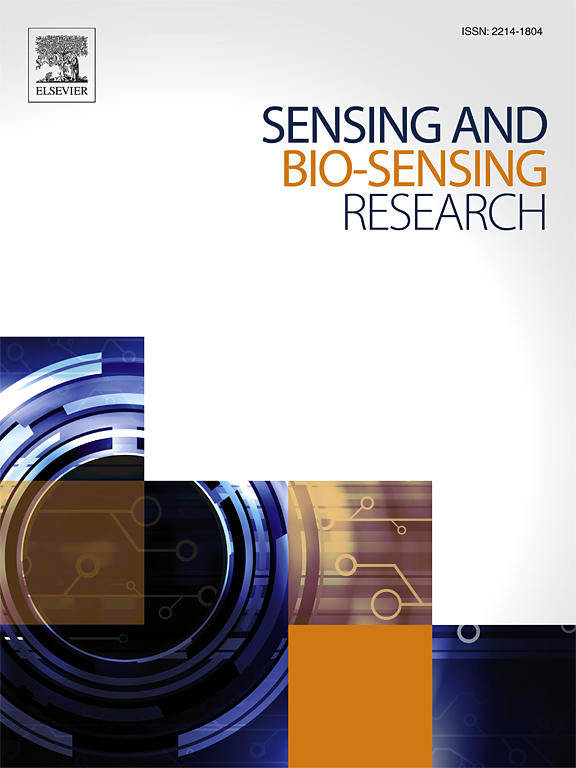Urinary glucose detection with spiral shape hollow core photonic crystal fiber: Towards improved diabetes management
IF 5.4
Q1 CHEMISTRY, ANALYTICAL
引用次数: 0
Abstract
Currently, diabetes is a prevalent ailment worldwide. Insufficient insulin leads to an inability to transform glucose into energy, resulting in increased amounts of glucose in human body. Acute diabetes treatment and follow-up rely on urine glucose detection since it provides a non-invasive, reasonably priced means to assess glucose levels and regulate the progression of the disease. This article presents the development of a circular shape core and semi-circular trapezoid air holes biosensor PCF to assess the glucose concentration in urine inside the THz band. With matching RI's of 1.335, 1.336, 1.337, 1.338, 1.341, and 1.347, glucose quantity in bio-sample spans 0 to 15 mg/dl (for as usual people) and 0.625 g/dL, 1.25 g/dL, 2.5 g/dL, 5 g/dL, and 10 g/dL (for diabetic patients) and achieve highest sensitivity is 99.12 %, EML loss 0.0021 cm−1, 2.24× 10−13 dB/m for 10 g/dl. The innovative design of this device guarantees precise and non-intrusive monitoring of the various stages of diabetes, allowing for timely and efficient control of the condition. This revolutionary sensor improves patient care and facilitates early intervention by offering a dependable and cost-efficient alternative to conventional approaches. Timely identification aids in averting complications and enhances patient prognosis.
螺旋形空心光子晶体光纤检测尿糖:改善糖尿病管理
目前,糖尿病是世界范围内的一种普遍疾病。胰岛素不足会导致葡萄糖无法转化为能量,导致人体内葡萄糖量增加。急性糖尿病的治疗和随访依赖于尿糖检测,因为它提供了一种无创的、价格合理的方法来评估血糖水平和调节疾病的进展。本文介绍了一种圆形核和半圆形梯形气孔生物传感器PCF的发展,用于评估太赫兹波段内尿液中的葡萄糖浓度。在匹配的RI值为1.335,1.336,1.337,1.338,1.341和1.347的情况下,生物样品中的葡萄糖量范围为0至15 mg/dl(正常人)和0.625 g/dl, 1.25 g/dl, 2.5 g/dl, 5 g/dl和10 g/dl(糖尿病患者),最高灵敏度为99.12%,EML损失为0.0021 cm - 1, 2.24× 10 - 13 dB/m为10 g/dl。该设备的创新设计保证了对糖尿病各个阶段的精确和非侵入性监测,从而及时有效地控制病情。这种革命性的传感器通过提供一种可靠且经济高效的替代传统方法,改善了病人的护理,促进了早期干预。及时识别有助于避免并发症,提高患者预后。
本文章由计算机程序翻译,如有差异,请以英文原文为准。
求助全文
约1分钟内获得全文
求助全文
来源期刊

Sensing and Bio-Sensing Research
Engineering-Electrical and Electronic Engineering
CiteScore
10.70
自引率
3.80%
发文量
68
审稿时长
87 days
期刊介绍:
Sensing and Bio-Sensing Research is an open access journal dedicated to the research, design, development, and application of bio-sensing and sensing technologies. The editors will accept research papers, reviews, field trials, and validation studies that are of significant relevance. These submissions should describe new concepts, enhance understanding of the field, or offer insights into the practical application, manufacturing, and commercialization of bio-sensing and sensing technologies.
The journal covers a wide range of topics, including sensing principles and mechanisms, new materials development for transducers and recognition components, fabrication technology, and various types of sensors such as optical, electrochemical, mass-sensitive, gas, biosensors, and more. It also includes environmental, process control, and biomedical applications, signal processing, chemometrics, optoelectronic, mechanical, thermal, and magnetic sensors, as well as interface electronics. Additionally, it covers sensor systems and applications, µTAS (Micro Total Analysis Systems), development of solid-state devices for transducing physical signals, and analytical devices incorporating biological materials.
 求助内容:
求助内容: 应助结果提醒方式:
应助结果提醒方式:


